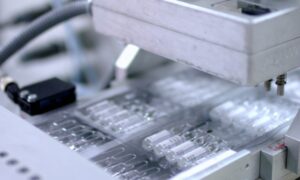
Manufacturing medical devices and medicines demands the highest cleanliness standards. Airborne bacteria and viruses are a constant threat. These tiny invaders can ruin products and cause health risks. But there’s a powerful solution: UV-C light. This special light can destroy the DNA of harmful microbes. It offers a new level of indoor air disinfection. Ultimately, this means safer products, which helps protect your reputation as a medical manufacturer.
Upgrade your disinfection strategy with Farlite Solutions. Our cutting-edge indoor air disinfection systems provide superior protection for your medical manufacturing facility. Contact us for a free quote today.
Stringent Clean Environment Standards in Medical Manufacturing
Many medical manufacturers must adhere to exceptionally strict sanitization protocols during production to ensure patient safety. This includes manufacturers of:
- Implantable devices: Pacemakers, stents, artificial joints
- Surgical instruments: Scalpels, forceps, retractors
- Wound dressings: Bandages, gauze, sutures
- Injectable medications: Vaccines, antibiotics, pain relievers
- Diagnostic devices: Imaging equipment, blood testing kits
Manufacturing these critical supplies demands cleanroom environments where contaminants like dust, microbes, and particles are strictly controlled.
Relevant Federal Regulations
There are several regulations and standards that address air quality in medical manufacturing. The FDA cGMP (Current Good Manufacturing Practice) outlines general principles for drug and medical device quality, including air quality control requirements. ISO 14644-1 in particular is a FDA-recognized standard that classifies cleanroom environments based on particle concentration. Medical manufacturing often requires different ISO classes depending on product sensitivity.
OSHA standards focus on worker safety, setting permissible exposure limits (PELs) for airborne contaminants potentially found in medical manufacturing. ANSI/ASHRAE Standard 170 addresses ventilation in healthcare facilities. Lastly, the USP (United States Pharmacopeia)
is a set of enforceable quality standards specifically designed to ensure the safe preparation of compounded sterile preparations, which could be applicable to some types of medical manufacturing facilities.
Indoor Air Disinfection Using UV Light
UV-C light is a specific portion of the ultraviolet light spectrum with a powerful germicidal effect. It works by attacking the DNA and RNA inside bacteria, viruses, and other microorganisms. This damage scrambles their genetic code, preventing them from replicating and causing harm. In continuous indoor air disinfection systems, UV lamps emit this light within the upper air of enclosed areas. As air circulates, harmful microbes are exposed to the UV light, effectively neutralizing them and improving indoor air quality.
This indoor air disinfection creates a potent extra layer of protection for sensitive medical products. By continuously cleaning the air, the risk of airborne contaminants settling on products or critical surfaces is drastically lowered. This translates to safer, higher-quality medical supplies. In addition, a cleaner environment safeguards the health of employees to lower the risk of airborne illness and lead to reduced absenteeism.
Expert Installation and Support for Indoor Air Disinfection
Selecting the most suitable indoor air disinfection solution requires careful consideration. With our in-depth knowledge of UV technology in indoor air disinfection, our team at Farlite Solutions can guide you through this process. Room size, layout, and airflow patterns all influence the proper installation of your device to maximize its effectiveness. Plus, our UV systems incorporate safety features to prevent accidental exposure to personnel. Contact us today and get a free quote for a custom solution designed for the specific needs of your medical manufacturing environment.
